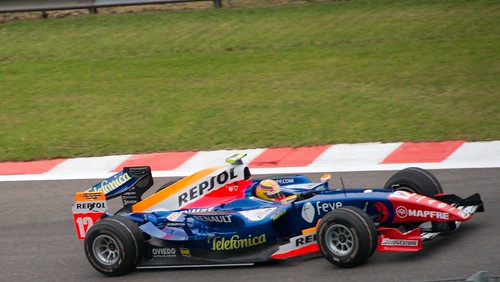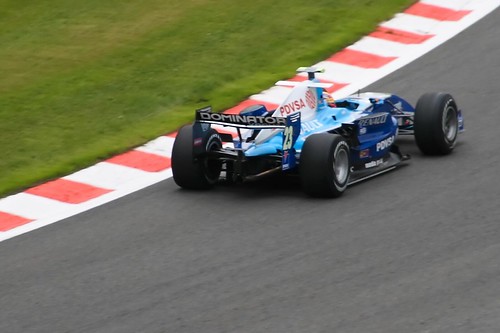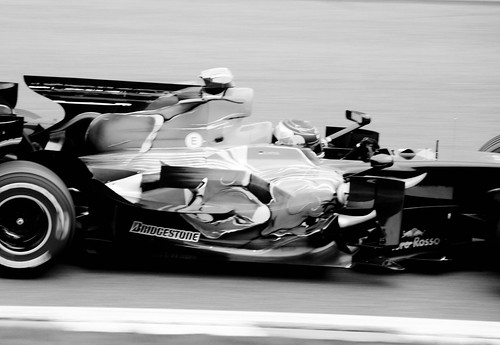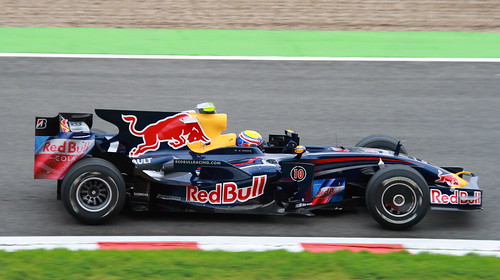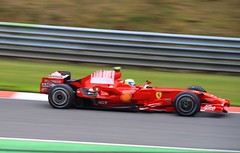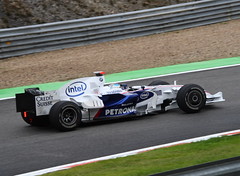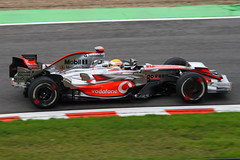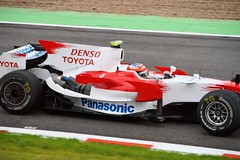Book Review: Crashed And Byrned - The Greatest Racing Driver You Never Saw
You might be wondering why I bring the story up. The answer is that I was reminded of it while reading Tommy Byrne's recently published autobiography, Crashed And Byrned - The Greatest Racing Driver You Never Saw. I'm not suggesting that the two are especially similar. Byrne may have had a wild side but the book does not suggest a man as fundamentally troubled as Gascoigne. It's more than they were both incredible natural talents who, perhaps because of their upbringing, or perhaps because of their innate disposition, were cursed with a self-destructive streak which made it difficult for them to make the most of their otherworldly abilities. Byrne may never have been as troubled as Gascoigne, but while football clubs are well used to handling and reining in wayward kids from difficult backgrounds, the moneyed world of professional motorsport was not.
Written with one of the best motorsport journalists of our time, Mark Hughes, this is a book which I had been looking forward to for a while, and it is certainly a driver biography quite unlike any other I have read.
Byrne came from a poor Irish family in a rural village outside of Dundalk. The early part of the book, recounting adventures from his childhood, will have a familiar ring to anyone who had read accounts of growing up poor in Catholic Ireland in the 1960s and 70s. Certainly, it is a world away from the upbringing of the man whom Hughes considered his only real rival in terms of outright pace, Ayrton Senna. Nonetheless, there's a curious parallel early on in the book. Both had their earliest driving experiences at the wheel of a tractor. However, while Senna picked this up on his millionaire father's vast cattle ranch, Byrne did so while helping out at a nearby farm whose owner had realised that the local kids provided a cheap (i.e. free) workforce to help him get the harvest in.
Byrne gets just one lucky break to get him started on the motorsport ladder, when his mother inherits a bit of farmland and he persuades her to borrow £3000 against it to buy Byrne an elderly Crossle Formula Ford. It's hopelessly uncompetitive, even in the backwater of Irish Formula Ford racing, but its enough to bring him to the attention of Mondello Park Racing School, who give him loan of a Royale for the 1978 Formula Ford Festival at Brands Hatch. In a field of several hundred, and on a track he has never seen before, he finishes in the top 10, in a car which was far from truly competitive. From there on in, he secures drives on talent alone - he has to - he certainly doesn't have the money to pay for rides.
The next four years of Byrne's career is the story of a meteoric rise through the ranks, achieved on a shoestring budget. Formula Ford 1600 champion in 1980, FFord 2000 champion a year later, and British F3 champion in 1982 with Murray Taylor Racing. It's told in Byrne's conversational, scattergun style, with co-author Mark Hughes adding occasional background commentary to move the story along. It's immensely readable, and provides an intriguing insight into the racing world of the early 1980s. It says much for Byrne's talents behind the wheel that he never paid for a drive. In F3, in particular, he scraped by from race to race, absolutely dependent on the wins to get the money together for the next race.
This part of the book also gives a flavour of what was perhaps both Byrne's greatest strength and his undoing - his sheer bloodyminded front. Here he was, racing for free in F3 where drivers are usually expected to bring the budget to the team, and he threatens to walk out on them unless they gave him a new chassis, engine and race engineer. He got the chassis, and sure enough, he was instantly right back on the pace - old engine and race engineer notwithstanding. But still, how many young, inexperienced drivers would have had the nerve to demand what he did from a team so clearly struggling for cash?
By late 1982, Byrne was a Grand Prix driver. After Derek Daly had been snapped up by Williams, Teddy Yip's ailing Theodore team were in need of a replacement, and following a standout performance in that year's British GP F3 support race, the team alighted upon Byrne. The car, and more particularly, the team, were a lost cause, and Byrne found himself no more able to get a competitive result out of it than Daly had been. He raced 5 times for Theodore, making it through qualifying only twice, and crashing out of both those races.
Then came the Mclaren test on which both Byrne and Hughes consider his career to have hinged. A prize for winning the British F3 title, Byrne was invited to test for the team alongside Thierry Boutsen, Stefan Johannson, and two men who subsequently disappeared into obscurity, David Scott and Quique Mansilla. By all accounts, Byrne was the star of the test - a second a lap quicker than Boutsen, who went on to have a successful F1 career and win 3 Grands Prix. Suggestions that the timing was faulty and he was actually faster still, and that the team were so nervous that Byrne would write off their car that they didn't give him full throttle, if true, indicate his performance was more impressive still. It wasn't enough to get him a race drive, and as he'd walked out on Theodore at the end of the 1982 season, Byrne was left without a seat for 1983.
The book takes an altogether different turn from here on in. Byrne's confidence, it appears, was always built on shaky foundations, and following the knock-back from Mclaren, he lost focus and his career went into a downward spiral. Three years later, he wound up racing in the US, driving for a succession of underfunded Indy Lights teams, and working on the side as a hired gun in the US IMSA series. There is more than a hint of Hunter S Thompson's Fear and Loathing about it, and a cast of grotesque characters such as could have come straight from a Carl Hiaasen novel.
There's Marshall Robbins, the manic-depressive multi-millionaire who is utterly convinced that he will win the 1992 US Presidential election, and who pays a succession of stooges to follow him around. Then there's Orchio, the Mexican bisexual playboy alcoholic who liked to celebrate team victories by hiring gaggles of prostitutes for team orgies and then trying to have his way with his driver - enough to make Max Mosley blanche, I don't doubt. He even ends up teamed up with Motley Crue's Vince Neal in a final, shambolic run at the Indy Lights Championship. It's gripping, comic stuff, but there's an underlying sadness about it all. Here is a man who just might have been one of the outstanding talents of his generation, wasting away in obscurity in the backwaters of the US racing scene, unrecognised, driving for any lunatic who'll pay his bills.
If I have a gripe with this book, it is that at just under 200 pages, it is too short. Too much is passed over without explanation. This may be in keeping with what one suspects is Tommy's hyperactive, attention-deficit personality, but it does sometimes leave the reader thinking - wait? Where is he now? Who's he driving for? I've heard it said that that the book was cut back considerably at the behest of the publishers, and had originally been rather longer. If so, it's a shame, because I suspect the longer book would have been a better read.
Of course, the book's central point is that Byrne was a great talent, in the same kind of league as Villeneuve, Senna or Prost, who was overlooked because an elitist sport couldn't get past his poverty-stricken background and his Irish urchin sense of humour. I'm afraid, even by the end, I'm not completely convinced. I can't help but think that a man as hair-trigger and temperamental as Byrne was probably not quite the complete package as a potential F1 World Champion. He might have had the talent, but did he have the application? The patience? Did he bring the same kind of intensity to his racing that, for example, Senna did? After all, while none may have come from the kind of dirt poor background that Byrne did, Messrs Kimi Raikkonen, Fernando Alonso and Michael Schumacher, who between them have won every F1 title this decade, were not born wealthy - they got where they did through sheer talent. What did they have that Byrne didn't? Luck, maybe, but one can't help but think that they also had a calmness, a focus on the job that Byrne lacked.
The sad thing is, we'll never know now. Not for sure. What Crashed and Byrned did persuade
me was that this was a man who was unfairly overlooked - someone who had done enough to merit a decent shot at F1, but who never got it. Why wasn't he banging on all the teams' doors after he won the F3 Championship in 1982? Why did he walk out on Theodore without another drive in place? Might he have got further had he hired a proper manager to promote him? This book might not answer those questions - they are unanswerable, but it is a racing biography quite unlike any other. I highly recommend it.
Labels: book review, crashed and byrned, formula 1 motorsport, mark hughes, motor racing, tommy byrne
